The best ecommerce platforms make it simple and easy to get your business online. These dedicated website builders supply you with all the tools you need to create and grow stunning, functional online stores that your customers will love.
But with countless ecommerce solutions to choose from, and with each one thinking they are the best, it can be hard to decode the marketing spiel and understand which one is truly the best for you and your business.
To help you make the right choice, our experts have tested the best website builders on the market and rounded up those that are best for creating online stores. Each covers all the basics (shopping cart software, payment gateways, an easy-to-use editor) and offers enough themes, templates, and customizations to make your store stand out.
Wix wins as the best overall ecommerce platform thanks to its extensive range of tools, features, and for how easy it is to use. Plans that include ecommerce features start at $29/mo, which is affordable for the majority of new and growing online stores.
Time to start or grow your online store? You’re in the right place.

Owain Williams
Owain has an extensive background in business and marketing. He has spent over 7 years testing website builders, building his own ecommerce stores, and writing about business and marketing topics.
Our top 3 best ecommerce platforms of 2024
In a rush? Below we have listed our top three ecommerce software picks along with a quick overview of why each is well worth considering when building an online store.
The best ecommerce platforms of 2024 in full
Below, you’ll find full write-ups of each of the best ecommerce platforms on our list.
The best ecommerce platform overall
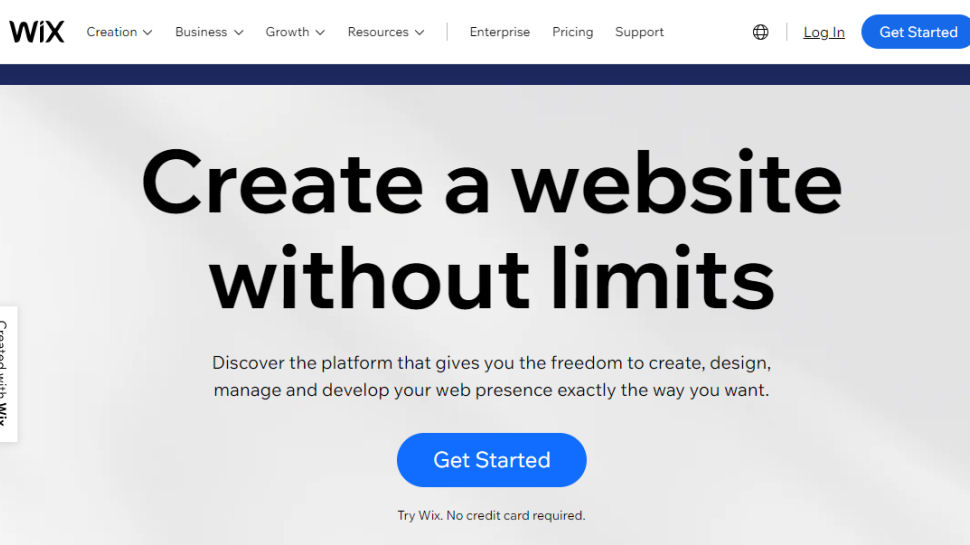
Buy it if
✅ You’re looking for built-in SEO tools: If you’re hoping to rank high on Google, but don’t know where to get started, Wix’s built-in SEO tools can take some of the pressure off while giving you tips and tricks.
✅ You want to try it out first for free: The free plan lets you trial the platform and all the tools it has to offer without paying a penny. Unfortunately, this comes at the cost of your site using a Wix domain.
✅ You want a platform that’s easy to use: Wix’s beginner-friendly approach renders it really easy to use, especially if you tap into its AI-powered tool, Wix ADI.
Don’t buy it if
❌ You don’t want to pay over the odds for ecommerce: Although there’s a free plan, this doesn’t offer ecommerce tools; only the most premium options have ecommerce tools.
❌ You’re a big business: Larger sites might not find Wix as useful as smaller ventures given Wix doesn’t provide unlimited resources with any of its plans.
❌ You’re constantly experimenting with your site’s look: Wix’s templates are useful, but you can swap them out for another once it’s set. If you want to change template, you’ll have to build your site again from scratch.
The bottom line
🌐 Wix is one of the best site builders and worth checking out, despite the fact it’s not perfect. It has something for everyone – whether you’re launching a blog or a professional site to promote your business, but larger sites may wish to look elsewhere. ★★★★½
What you need to know:
Wix is a beginner-oriented website builder and an all-in-one tool that’ll equip you with everything you’ll ever need to build a beautiful website. It comes in the package with a web hosting service and a domain name, free or paid.
We found the ecommerce features on Wix simple and easy to use. Its simplicity makes it an ideal option for small businesses that want to quickly and easily upload products and start selling online.
Although we didn’t set up a large scale ecommerce store, it is clear Wix’s limited resources may prove an issue in these circumstances. If you want a platform with fewer limits, BigCommerce is worth checking out.
Plans and pricing:
Although Wix offers a free and low cost ‘Light’ plan ($17/mo), if you want to sell online you will need to opt for one of its more advanced plans.
The cheapest plan that will allow you to sell online is the ‘Core’ plan ($29/mo). This gives you all the basics you need to build your website along with ecommerce tools such as the ability to sell up to 50,000 products, accept online payments, send abandoned cart emails, and apply automatic discounts.
Taking a step up to the ‘Business’ plan ($36/mo) will give you everything from the ‘Core’ plan along with unlocking reviews, advanced shipping options, and up to 5 additional currencies.
Business Elite ($159/mo) takes this one step further, adding a loyalty program along with more advanced versions of many of the tools you get with the lower level plans.
Wix is a great option for building an ecommerce store, but it certainly isn’t the cheapest. In our Wix vs Weebly study, we found that although Wix offers better ecommerce and website builder features, Weebly is a strong competitor and costs considerably less, with premium packages starting at just $10/mo.
Ease of use:
Boasting its beginner-friendly approach, Wix is one of the easiest site builders to use, particularly if you don’t mind putting your trust in its AI-powered tool Wix ADI. In a matter of minutes, Wix ADI will build a site for you, though a basic one. So, you’ll still want to utilize the editor and touch up your newly created site.
Features:
Wix offers a cloud hosting service and a domain name with its packages. All plans come with a free SSL certificate and bandwidth is unlimited on most plans too, but storage space is sadly capped on all packages. Its e-commerce features, available with Business Basic on upwards, cover all core functionality you’d expect. Wix allows you to accept online bookings for appointments, schedule online services, manage your staff, stream videos, and much more.
Elsewhere, Wix includes a nifty site builder with three types of editors to create your wite, alongside a swathe of templates. The Wix App Market can also add extra features and functionality to your site, with more than 500 apps on offer.This is alongside the Wix Ascend all-in-one business solution for website owners, which includes tools like email marketing, branding and SEO.
Support:
Wix provides a 24/7 callback service and live chat support from Monday to Friday, 2 AM – 6 PM (ET). In addition to English, live chat is also available in ten other languages including French, German, and Italian. Wix Help Center offers lots of step-by-step guides you can browse via categories, or a search box – which we prefer.
Read the full review: Wix review.
The best ecommerce platform for WordPress
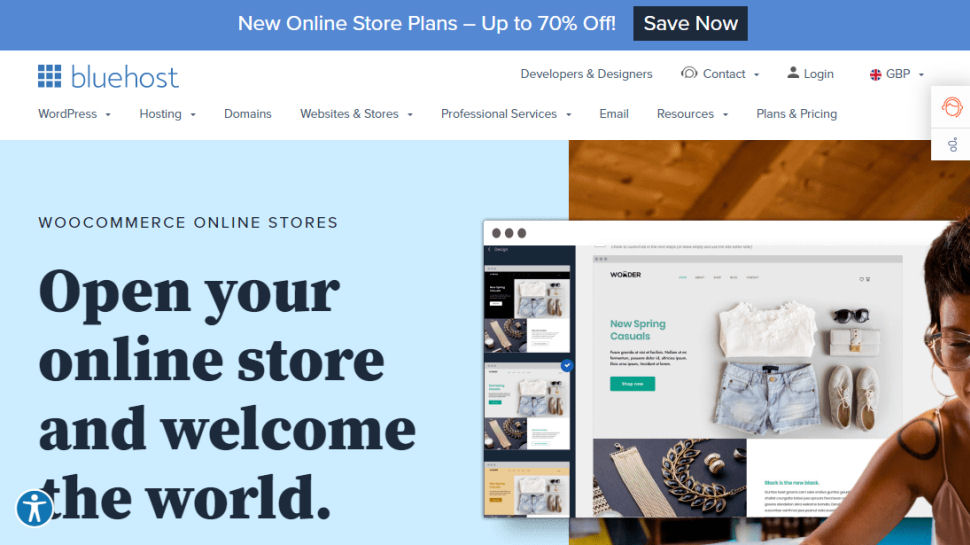
✅ You’re looking to make the most of templates: Bluehost makes it easy for people to build a website with a plethora of templates and media sources, with prebuilt designs for different components that make up the site.
✅ You need performance guaranteed: We reported no outages during testing, and response times averaged 1.95ms, which is incredibly fast, given most providers average between 200-400ms.
✅ You want to build a WordPress site: WordPress recommends Bluehost becaue of its customer service and expertise, and the platform has offered plans optimized for WordPress since 2014.
Don’t buy it if
❌ You need an email account: Although there are great advantages to using Bluehost, you can’t buy an email address with its various packages.
❌ You want to pay monthly: There’s no monthly payment option for Bluehost’s website building plans, and you have the option to commit to 12 months or 36 months.
❌ You’re looking for a novice-friendly eccomerce platform: Like most open-source solutions, WooCommerce isn’t the most beginner-friendly and it isn’t included in the base plan.
The bottom line
🌐 Bluehost + WooCommerce work together extremely well to give you an ecommerce solution optimised for WordPress. You get complete control over your site and plenty of templates to help you get underway, alongside a great variety of ecommerce tools. ★★★★
What you need to know:
Instead of being a standalone ecommerce platform, WooCommerce is a free plugin that can turn your WordPress site into a fully functional e-commerce store. Like most open-source solutions, WooCommerce isn’t the most novice-friendly option around.
Fortunately, Bluehost simplifies the process by providing a ready-made WooCommerce platform with everything you need already installed, and that includes a shopping theme and essential plugins.
Although building an online store on WordPress can be a little daunting, we found it pretty easy when using Bluehost. However, if you are a complete novice, another option (such as Wix) may make more sense. Even with our background in testing and using website builders, we found some elements of setting up and using the WordPress platform for online selling a little confusing.
Plans and pricing:
Bluehost offers three plans for its website builder. The Basic plan is intended for personal websites and blogs, while the others are aimed at businesses and store owners. Priced at $2.95 per month, for a 12-month subscription, the Basic Plan renews at $10.99 per month. If you want to deploy an online store, you must choose between the Pro and Online Store plans. The Pro plan is priced at $9.95 per month, for a 12-month subscription and renews at $14.99 per month. The Online Store will similarly cost you $24.99 per month, and renews at $39.95 per month.
Ease of use:
Bluehost provides an easy to use, intuitive drag-and-drop builder that can help you assemble a website, as well as tweak it’s appearance and add different elements in almost no time at all. The custom-built WooCommerce platform, integrated into Bluehost, also makes it as easy as possible to tap into the features that make WooCommerce so powerful.
Features:
All packages include a bevy of useful hosting essentials such as free SSL and domain name, albeit for the first year only. Hosting is included, too. The basic plan also includes free CDM, alongside 50GB SSD storage space.
The Bluehost Website Builder is built on top of WordPress, and serves to provide a more streamlined and straightforward interface for building websites using WordPress. Novice users will appreciate the drag-and-drop Website Builder which lets you assemble robust websites with any technical know-how, coding skills, or even familiarity with WordPress.
Support
While our experience with billing and the customer support was satisfactory, a quick look at Trustpilot reveals a different story. At present, Bluehost scores a rating of 3.2 out of 5. Most of the reviews are from dissatisfied customers expressing frustration at their interaction with the technical support and questions about billing.
Bluehost used to offer a ticket-based support system but that’s been discontinued. Your only options are phone support, live chat, or scavenging for a solution on the Knowledge Base. There’s also a Knowledge Base with guides split across eight broad categories – with all guides including step-by-step instructions.
Read the full review: Bluehost Website Builder review
The best ecommerce software without limits
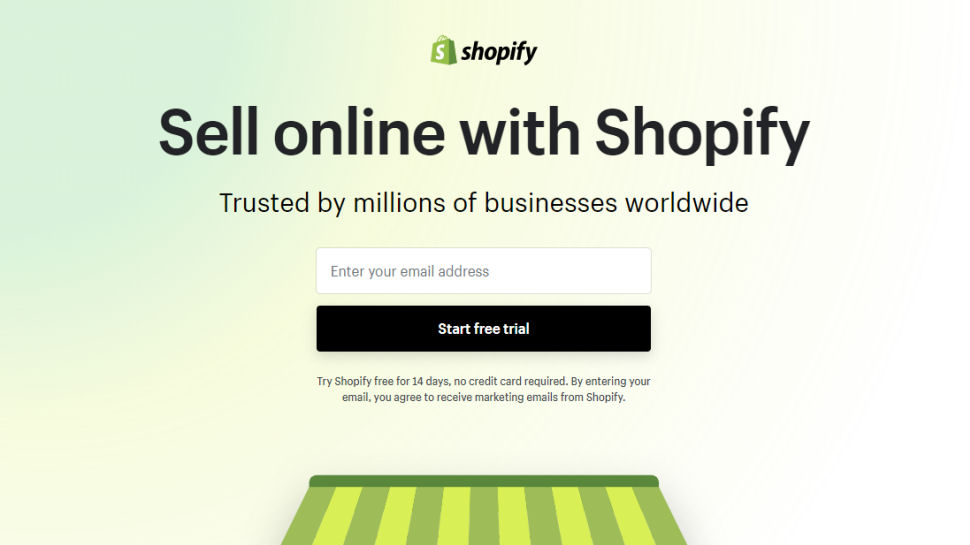
Buy it if
✅ You want no limits: Shopify doesn’t include nearly as many annoying limits or catches as you’ll get with other platforms, including unlimited product, bandwidth and disk space – alongside a free SSL certificate.
✅ You want a broad choice of extensions: The template-style builder is complemented with a rich variety of integrations and other apps, including shipping and inventory management.
✅ You need advanced analytics: Shopify’s built-in analytics offers an at-a-glance view of important business stats, with individual reports giving you more detail.
Don’t buy it if
❌ You want to avoid paying a premium: Shopify’s various plans, while rich with tools and features, are on the pricy side, with the most expensive tier priced at $299 per month.
❌ You want a basic or free plan: Although the basic plan is available for a reasonable monthly fee, it doesn’t include gift cards or Shopify’s monthly reports. There’s also no free plan, but there is a 14-day trial for all plans.
❌ You’re wary of transaction fees: Transaction fees are present throughout Shopify’s packages, and apply to both credit card and in-person charges, but they scale down with more premium plans.
The bottom line
🌐 Shopify represents an easier way to build and manage your web store, but there are more powerful platforms around and you need to pay a relative premium when you compare it to a number of competitors. ★★★★
What you need to know:
Shopify is perhaps the most well-known ecommerce software as we write and it came a long way since its inception in 2006. True to its word, to use Shopify to create a beautiful online store you don’t require any technical or design skills.
It’s a one-stop e-commerce platform that provides everything you need to build and grow your web store: a template-based site builder, comprehensive product catalog, easy payment processing, automated fulfilment via shipping apps and other integrations, inventory management, powerful analytics and more.
I built my first ever online store using Shopify and found it a breeze. Although the features were easy to use, they offered considerable breadth and power, making it an ideal ecommerce solution for businesses of all sizes.
Owain Williams, Editor at TechRadar
Plans and pricing:
The Basic Shopify plan is available for $29 (around £22.70) a month, and includes a free SSL certificate, and no limits to bandwidth, disk space or products. The only penalties come in the way of only two staff users and 2.2% + 20p transaction fees for online orders and 1.7% + 0p for in-person payments.
Upgrading to the $79 (around £61.80) Shopify account cuts online credit card charges to 1.9% + 20p, and in-person ones to 1.6%. You also get gift cards, professional reports, up to five staff accounts, and five locations. The most expensive tier is the ‘Advanced Shopify’ at $299 per month (around £234). This cuts the online credit card charges down to 1.6% + 20p, in-person charges to 1.5%, gives you up to 15 staff accounts, and can handle 8 locations. Shopify also offers a free 14-day trial, with no credit card details required.
Shopify is purpose built to support online stores, but certainly isn’t the cheapest option. If you are looking for something more budget friendly, Weebly is a more affordable alternative. You can get selling online for free with Weebly, although you will have a host of limitations. Paid plans start at just $10/mo.
Ease of use:
The Shopify interface does its best to keep options to a minimum. A left-hand sidebar organises features into straightforward categories – Orders, Products, Customers, Analytics, Marketing, Discounts, Apps – while the Dashboard highlights how you should get started (add products, then customise your store). It’s all very clean and simple.
One problem with this minimalist approach is it’s not immediately obvious where you should look to carry out a particular task. Fortunately, a well-designed search system is on hand to point you in the right direction.
Features:
Shopify provides a full-fledged CMS users can use to manage site functionality and layout, which they can also do via Shopify’s mobile apps. A live chat function allows you to have a real-time conversation with your customers, and there’s built-in support for 3D models and videos. Plus, you get an option to create customizable storefronts on Facebook and Instagram.
Shopify also offers unlimited hosting for their stores, in-depth analytics of how visitors are using the store, and powerful marketing tools such as SEO optimization, discounts, a coupon engine, gift cards, and email marketing tools.
Support:
Shopify offers round-the-clock customer support via telephone line, live chat, and email. During testing we found support to be responsive and helpful, which can be mighty helpful when faced with a challenge in setting up, running, or growing your online store.
Read the full review: Shopify review
The best ecommerce platform for analytics
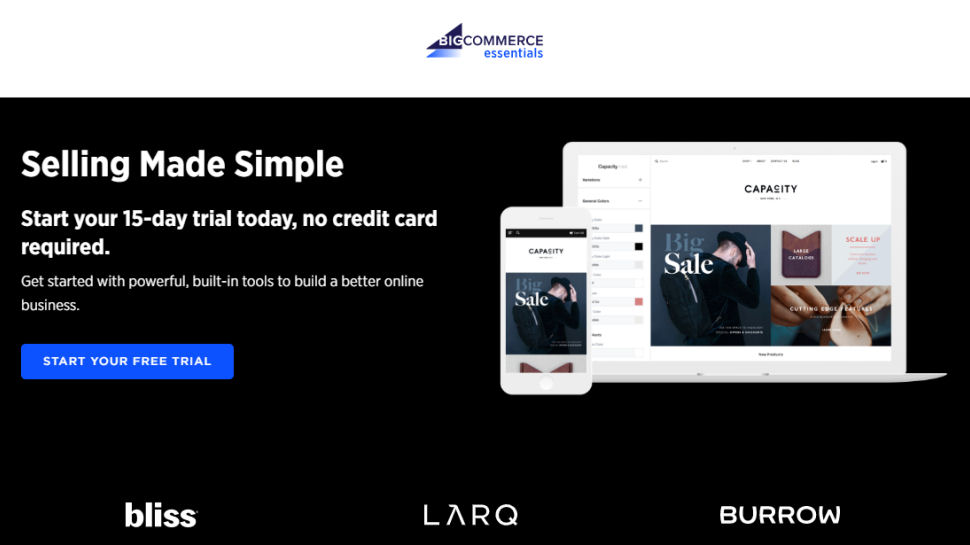
Buy it if
✅ You want loads of built-in tools: The platform features customizable templates, integrated payment processing systems, built-in marketing tools, and more.
✅ You want great customer support: You can access live chat support through its website, alongside phone support and an email address you can contact – with an agent getting in touch in under 24 hours.
✅ You want to take advantage of analytics: BigCommerce offers real-time analytics, with access to experts qualified in both Google Analytics and Adwords who can offer advice.
Don’t buy it if
❌ You’re just starting out: Although BigCommerce is user-friendly, it isn’t the most beginner-friendly platform out there and may seem overwhelmingly complex if you’re just starting out.
❌ You want extensive customization options: Although there are a variety of templates you pick out and customize, these are limited when you compare it to those offered by competitors.
❌ You’re looking for value-for-money: BigCommerce is fantastic if pricing isn’t an issue for you, but with a number of expensive plans, those looking to making savings should probably shop elsewhere.
The bottom line
🌐 BigComerce is a feature-rich e-commerce solution that’s prefect for the large businesses and enterprises – that is, if pricing isn’t an issue. With tools, customer interaction and integrations everywhere you look, you can build the perfect website to support your growing business. ★★★★
What you need to know:
Launched in 2009, BigCommerce is today one of the leading e-commerce platforms providing a splendid level of scalability for online stores – meaning it can follow and shape your business’ growth.
Much like Shopify, BigCommerce provides a variety of templates and themes to help stores look their best and get up and running quickly. Alternatively, users can design their own store or employ BigCommerce designers to do so. The platform incorporates a full-featured CMS that allows users to run an entire site, rather than just an online store.
During testing we found that BigCommerce offers all the tools and features you would expect from a dedicated piece of ecommerce software.
However, with a slightly higher level of complexity than the likes of Shopify, we also found that BigCommerce is better suited to established ecommerce brands that already have a basic understanding of how ecommerce platforms function.
Plans and pricing:
BigCommerce’s Standard plan starts at $29.95/month and includes everything you need to get started. BigCommerce Plus plan starts at $79.95/month and includes all the features in the standard plan plus a number of others including customer groups and segmentation, abandoned cart saver, and more advanced reporting tools.
The Pro plan is BigCommerce’s basic website builder package and starts at $299.95/month. It includes all the features of the Plus plan plus Google customer reviews, product filtering, and custom product filtering. It also offers online sales up to $400k per year.
Ease of use:
BigCommerce offers a robust suite of features that make it easy to build a website from scratch. The drag-and-drop builder makes it easy for users to customize their site without needing any coding skills. The platform also offers plenty of features to help you manage your store once it’s up and running. You can easily add products, manage orders, process payments, track inventory levels, and more. The only downside is it might not be suitable for beginners, given the breadth of tools and features available.
Features:
Users can benefit from detailed and flexible product management, optimized search engine rankings, along with a variety of integrated marketing tools and analytics.
Payments can be accepted via over 65 pre-integrated gateways, and shipping details can be customized as per the business’s requirements. As of late, some new features have been added like support for Amazon Import and Link and Shopping in Instagram Stories.
The platform offers automated order processing, flexible tax rules depending on where orders are made and shipped, and support for over 140 currencies. One of the great tools that come with BigCommerce, meanwhile, is BitPay – the world’s largest provider of Bitcoin and cryptocurrency payment services.
Support:
BigCommerce offers live chat support directly from its website. If live chat is different from your style, BigCommerce also offers phone support for their customers. For those who prefer written communication, BigCommerce provides email support as well. All you have to do is fill out an online form on their website and one of their team members will get back to you within 24 hours (or sooner).
Read the full review: BigCommerce review
Best ecommerce platform for small business
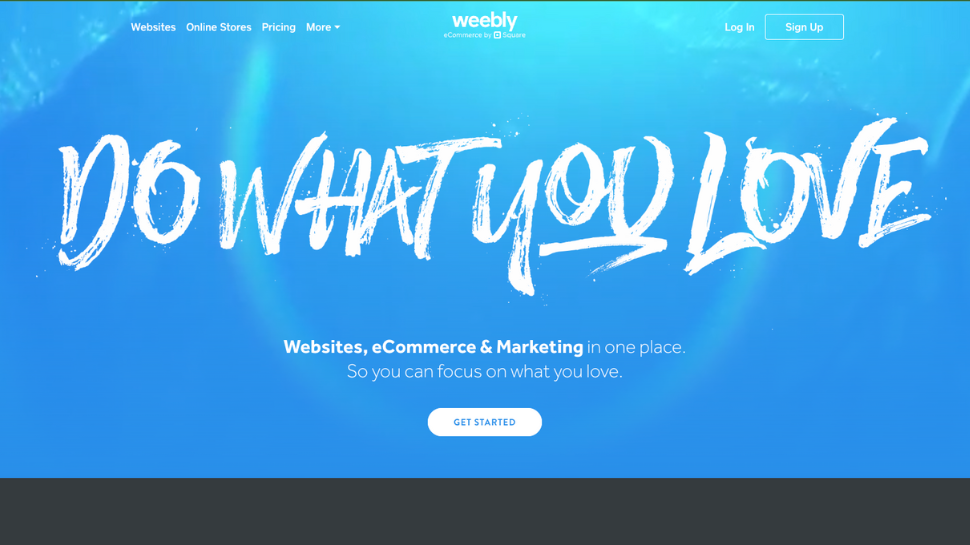
Buy it if
✅ You’re a small business owner seeking an intuitive website builder with robust ecommerce capabilities: Weebly’s beginner-friendly drag-and-drop builder and a solid collection of themes make it easy to create a professional website without any coding expertise.
✅ You’re looking for a platform with transparent pricing and guaranteed uptime: Weebly offers upfront pricing and a solid 99.99% uptime guarantee, ensuring your website stays accessible at all times.
✅ You want a solid forever-free tier: Weebly provides access to all features on the free plan, making it an excellent option for those looking to explore the platform without committing to a paid subscription.
Don’t buy it if
❌ You require extensive customization options: While Weebly offers a range of tools suitable for small businesses, larger ones may find its capabilities lacking.
❌ You anticipate large fluctuations in sales volume: Weebly’s plans come with sales limits, and exceeding these limits may result in automatic upgrades to higher-priced plans, which will increase costs considerably.
❌ You prefer platforms with maximized storage space: Weebly’s paid plans have limitations on storage, which may not be suitable for businesses requiring ample storage space.
The bottom line
🌐 Weebly is a top choice for small businesses and solo entrepreneurs seeking a hassle-free website-building experience. With its intuitive drag-and-drop interface and extensive library of mobile-friendly themes, Weebly makes it easy to create stunning websites without any coding knowledge.
While it may not offer as many customization options as some other platforms, Weebly’s simplicity and affordability make it an ideal choice for small businesses looking to establish a professional online presence quickly and efficiently.
What you need to know:
Launched in 2006, Weebly has made its mark as a well-liked website builder, striking a balance between simplicity and functionality. Its drag-and-drop interface allows you to customize your site with ease, while its robust ecommerce tools make it a smart choice for an online store.
Weebly is a fantastic option for budget conscious online stores. However, it comes with customization, product, and storage limitations. Large, growing, and ambitious online stores are likely to be better off with a dedicated ecommerce software such as Shopify or BigCommerce.
Plans and pricing:
With Weebly, you’ll find several subscription plans for different business needs. The Personal plan, starting at $10/month billed annually or $13 month-to-month, provides essential features for individuals and small businesses. The Professional plan, available at $12/month billed annually or $18 month-to-month, offers additional ecommerce capabilities and priority support.
For businesses looking for advanced features, the Performance plan, priced at $26/month billed annually or $29 month-to-month, includes PayPal integration, abandoned cart recovery, and much more.
Ease of use:
Navigating Weebly’s website-building process is a breeze, thanks to its drag-and-drop interface. Whether you’re a tech whiz or just getting started, you’ll find it easy to customize your site with Weebly’s intuitive design and helpful how-tos along the way.
Features:
We’ve explored Weebly’s toolkit extensively, and while we’ve found plenty to love, there are a couple of areas where it doesn’t quite hit the mark for us. We’re big fans of its selection of mobile-responsive themes and essential features like SEO optimization and ecommerce tools.
However, we have to admit that some of the available templates didn’t quite meet our expectations in terms of quality. Likewise, while Weebly offers a decent level of customization, we found that it falls short compared to some other platforms we’ve tried.
Support:
If you have a question, Weebly’s got your back. Whether you prefer to shoot them an email, chat online, or give them a ring, their friendly support team is ready to assist. Plus, if you’re on a higher-tier plan, you’ll enjoy priority support and even phone assistance for those trickier questions.
Read the full review: Weebly website builder review
The best ecommerce platform for shop design

Buy it if
✅ You’re new to website building: Squarespace’s good-looking templates and user-friendly drag-and-drop interface make it perfect for those new to website creation, requiring no coding skills at all.
✅ You require diverse template options: With over 100 mobile-responsive templates available, Squarespace offers a wide range of options suitable for various purposes.
✅ You seek scalability and support: Squarespace offers unlimited bandwidth and storage, along with integrated e-commerce features, giving your growing business the solid support it needs to handle more traffic and transactions.
Don’t buy it if
❌ You plan to sell in multiple currencies: Squarespace’s transaction fees and lack of support for selling in multiple currencies may not be suitable for businesses operating in diverse markets.
❌ You prefer telephone support: Squarespace’s customer support options do not include telephone support, which may be a drawback for users who prefer direct assistance.
❌ You want extensive customization choices: While Squarespace offers a solid set of features, its customization options may be limited for users with specific design needs or branding requirements.
The bottom line
🌐 Squarespace is a standout option, especially if you’re looking to create an eye-catching website with minimal fuss. We particularly enjoyed its vast array of beautiful templates and its intuitive interface, which made the whole website-building process a breeze.
While it might not offer as much customization as some other platforms, Squarespace more than makes up for it with its comprehensive feature set and reliable support. So, if you’re in the market for a website builder that prioritizes design and user-friendliness, Squarespace is worth a shot.
What you need to know:
Squarespace is a one-stop solution for all things website-related. Whether you’re looking to catch a domain, host your site in the cloud, or build a stunning online store, Squarespace has got your back. What’s best is that you don’t need to be a tech whiz to make a beautiful yet professional website – their user-friendly system and drag-and-drop interface make it surprisingly simple.
Although Squarespace offers some of the most stunning website templates on the market, there are limits on how far these can be customized. In our Wix vs Squarespace study, we found that Wix is a better option if the ability to edit and change your website’s look and feel is important.
Pricing and plans:
When it comes to pricing, Squarespace offers four distinct plans, starting from $16 and going up to $53/month, with options for annual billing for those who prefer it. Regardless of the plan you choose, you’ll get essential features like unlimited bandwidth and storage, along with a complimentary custom domain.
It’s worth noting that the “Business” plan carries a 3% transaction fee on sales, which could impact businesses with growing sales volumes. However, if you opt for the Commerce (whether Basic or Advanced version), you’ll enjoy the benefit of no transaction fees, which makes it a solid choice for businesses focused on sales.
Ease of use:
Squarespace prides itself on its user-friendly approach, making website building a breeze for both beginners and seasoned pros. With its drag-and-drop interface and a wide selection of pre-designed templates, crafting a professional-looking website is as simple as it gets.
However, if you’re thinking of switching templates down the line, be prepared to start from square one, as there’s no way to seamlessly transition between them.
Features:
As we delved into Squarespace’s feature set, we were glad to discover a wide array of tools designed to elevate your website. From media marketing functionalities to seamless ecommerce integrations, Squarespace truly has it all. Plus, the robust analytics tools provided allow you to stay on top of your site’s performance without much effort.
It’s worth mentioning that while you have the freedom to add unlimited products to your online store and leverage SEO and social media marketing features, some functionalities, such as manual payments and multi-currency selling, may not be as comprehensive as those offered by competitors like Shopify.
Support:
If you ever find yourself in need of assistance, rest assured that Squarespace has your back with a range of support options. Whether you prefer reaching out via live chat, email, or social media channels, help is always just a click away. We particularly appreciated the availability of live chat support during the workweek, which ensures prompt assistance in case of trouble.
Additionally, Squarespace’s well-stocked Help Center, complete with video guides and a bustling community forum, offers valuable self-service solutions. However, it’s worth noting that if you prefer resolving issues over the phone, this option isn’t currently available.
Read our full review: Squarespace website builder review
Best for beginners
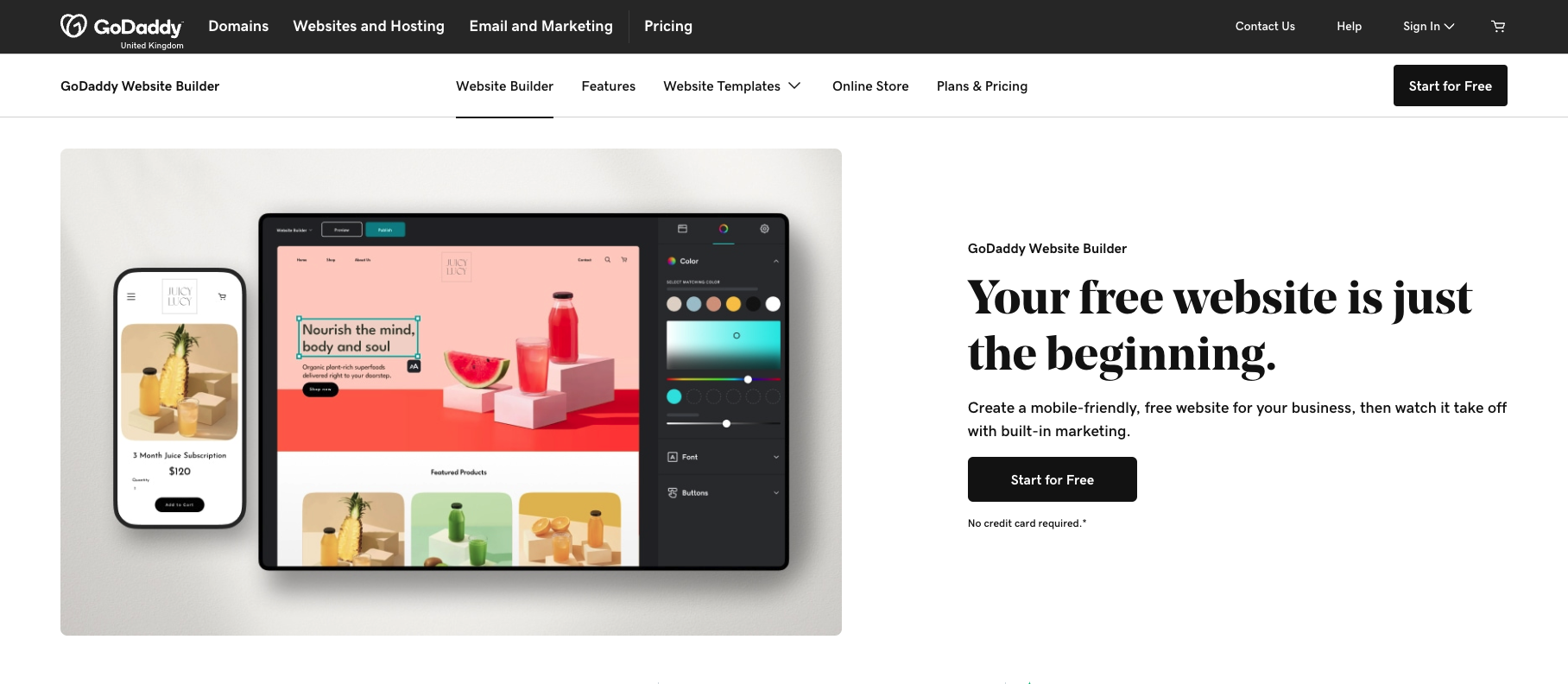
Buy it if
✅ If you’re a startup eager to get your online store up and running swiftly: GoDaddy’s user-friendly ADI tool makes the process a breeze.
✅ You’re seeking simplicity and convenience: GoDaddy’s ADI feature lets you create a website by answering a few questions, which is perfect for those who want to skip the complexities of extensive customization.
✅ You want built-in marketing tools to boost your online presence effortlessly: GoDaddy’s got you covered with great options for email campaigns and performance analysis.
Don’t buy if
❌ You crave full control over your website’s design and layout: GoDaddy’s ADI approach will likely feel limited in terms of creative freedom.
❌ You seek advanced ecommerce features: While GoDaddy’s platform is easy to use, it may lack the depth and customization options found in competitors like Squarespace and Shopify.
❌ You want a seamless checkout experience for your customers: GoDaddy’s ecommerce solution redirects customers to a different domain during checkout, which could raise trust and branding concerns.
The bottom line
🌐 GoDaddy’s website builder, powered by ADI, offers a quick and easy way for startups and small businesses to establish an online presence. We appreciated its intuitive interface and handy marketing tools, making it a solid choice for those looking for simplicity.
However, we found its limitations in creative control and ecommerce features might not suit everyone’s needs, particularly those with more complex requirements or larger-scale businesses.
What you need to know:
Founded in 1997 and renowned for its domain registration and web hosting services, GoDaddy also offers a rock-solid website builder solution. With a user-friendly interface and competitive pricing, this website builder is an attractive option, especially for newcomers diving into the world of online presence creation.
Whether you’re already a GoDaddy customer or exploring options for your website, we believe GoDaddy’s easy-to-use website builder is worth considering. However, if you need extensive ecommerce tools and feature, an alternative such as Shopify may be a better fit for you.
We have also compared Wix vs GoDaddy. Our tests found that although Wix certainly offers a more complete and editable platform, GoDaddy delivers all the features you need to create a simple, yet effective online store – all at a significantly more budget friendly price.
Pricing and plans:
From individuals to small businesses and all sizes of e-commerce ventures, GoDaddy offers flexible options. We also appreciated the inclusion of a free plan, allowing users to test the platform before committing to a paid subscription.
Starting at $10.99/month, the Basic plan includes essential features such as SSL, custom domain connection, and customer support. If you need more flexibility, the Standard plan, priced at $10.49/month, offers increased email and social media limits, along with built-in SEO options.
For those seeking even more features, the Premium plan, priced at $14.99/month, supports unlimited social media platforms and posts, along with appointment scheduling and reminders. Meanwhile, the Ecommerce plan, starting at $16.99/month, provides solid features for online selling, including product listings, flexible payments, and promotional tools.
It is worth noting that the rates we quote above are introductory rates and will increase once your plan automatically renews, so it is worth checking what you will pay after the introductory period is over.
However, while GoDaddy’s pricing is competitive, we found that some features may be lacking compared to other providers in the market.
Ease of use:
Our experience with GoDaddy’s website builder revealed its user-friendly nature, making it ideal for individuals with limited website-building experience. Powered by artificial design intelligence (ADI), GoDaddy simplifies the website building process, guiding users through customization options effortlessly.
However, we did notice that the use of ADI limits creative freedom, and the design templates may feel somewhat rigid for users seeking more customization options.
Features:
GoDaddy’s website builder offers a solid suite of business tools, including appointment scheduling, email marketing, social media management, graphic design, and CRM functionalities. We particularly liked how these integrated tools made it easier to manage different aspects of our website and marketing efforts in one place.
However, it’s important to note that while these tools are effective for basic needs, users requiring more advanced features may find them lacking compared to specialized platforms. Additionally, we found that the builder’s design customization options are somewhat limited, which may restrict users seeking a high level of creative control over their websites.
Moreover, we observed that the availability of app integrations is relatively restricted, which could pose challenges for users looking to extend the functionality of their sites beyond the built-in features. Despite these limitations, we found GoDaddy’s website builder to be a user-friendly option for start-ups and small businesses seeking a comprehensive online solution.
Support:
At GoDaddy, users can expect comprehensive support options tailored to their needs. The knowledge base features helpful how-to videos and guides, complemented by round-the-clock customer support, an active community forum, and informative blog posts.
You have access to live chat support, which initially connects you with a chatbot and then transfers you to a human agent if further assistance is required. Additionally, you can contact GoDaddy via phone support, with toll-free numbers available in select countries.
From what we’ve observed, GoDaddy aims to deliver timely support, but the response times may vary depending on the volume of support requests.
Read the full review: GoDaddy website builder review
How to choose the best ecommerce platform for you
In today’s fast-paced online marketplace, finding the perfect ecommerce software can be your business’s best buddy. However, with so many choices out there, it’s critical to think about what you really need to ensure this platform aligns with your business goals and needs. To cut to the chase, here are a few things you’ll want to consider before selecting an ecommerce platform for your business:
1. Tools and functionality
When evaluating ecommerce solutions, keep an eye out for essential tools like SSL certification, fraud prevention, data backups, and PCI compliance. These are the foundation stones that ensure your customers’ data remains safe and secure.
To boost your site’s visibility, seek out platforms that offer SEO-friendly features such as customizable meta descriptions, integrated blogging capabilities, and customer review functionalities. Additionally, prioritize platforms that embrace responsive web design, ensuring seamless access across all devices.
To steer your business in the right direction, look for platforms that provide built-in analytics features, allowing you to track store performance and spot emerging trends. Consider platforms that support multiple selling channels, from social media platforms like Facebook Messenger to established marketplaces like Amazon, to expand your market reach and revenue streams.
Lastly, opt for platforms that offer extensive integrations and plugins, empowering you to customize and enhance your store’s functionality as your business evolves. Also, having active community support can provide ongoing improvements and swift issue resolution to keep your ecommerce venture ahead of the curve.
2. Price and costs
While open-source software may appear budget-friendly upfront, it’s crucial to weigh in other expenses like web hosting fees, security compliance, and ongoing maintenance. Also, keep an eye on transaction fees, as they can significantly spike up your overall costs.
On the flip side, subscription-based platforms may require a monthly fee, but they often include maintenance and support services, making them a cost-effective option in the long run. Don’t forget to consider your budget and future growth plans when evaluating the pricing models of ecommerce software.
3. Security
With the increasing prevalence of online threats, security is more important than ever, especially for ecommerce software. When selecting a platform, it’s crucial to prioritize security features like SSL encryption, data encryption, and tools to prevent fraud. Make sure the platform you choose is committed to protecting your customers’ data and regularly updates its security measures to keep up with evolving threats.
After all, safeguarding your business from cyber threats is crucial for building trust and maintaining a successful online presence.
4. Ability to grow your store
Scalability is essential for the long-term success of your ecommerce business. Choose a platform that offers features tailored to accommodate your business’s expanding needs, such as flexible infrastructure, customizable designs, and seamless integrations with third-party applications.
Additionally, consider platforms that support omnichannel marketing strategies, which will allow you to reach customers across multiple channels and boost sales.
All in all, picking the best ecommerce software is a bit like putting together a puzzle – you need to find the pieces that fit perfectly. By considering your needs and priorities, you’ll be able to pick out a platform that helps your online business grow and thrive.
How we test ecommerce platforms
First, we’ll check what type of e-commerce platform we’re looking at: hosted or self-hosted; proprietary or open-source; SaaS or PaaS. Then we’ll see what ecommerce packages are available, how many tiers there are, and how much they cost – both long-term and short-term.
Then we’ll evaluate the ease of use (how simple it is to sign up, set up an online store, and customize it), highlight any unique features, the level of flexibility, and figure out what value for money these platforms provide.
In conclusion, we’ll estimate how their products compare with the competition.
You can read more about how we test website builders at TechRadar.
Best ecommerce platforms: Summary
In our search for the best ecommerce platforms, we’ve discovered that simplicity, functionality, and standout design are crucial.
Wix stands out as an all-in-one solution, perfect for newcomers with its intuitive interface and comprehensive features. WooCommerce, while a WordPress plugin, offers robust ecommerce capabilities when paired with web hosting from Bluehost, simplifying the setup process. Finally, Shopify shines as a powerhouse platform, providing everything needed to create and grow an online store without requiring advanced technical know-how.
Whether you’re a novice or a well-versed entrepreneur, consider factors like hosting options, technical proficiency, and desired store features when choosing the best platform for your ecommerce venture. If you’re ready to dive in, explore your top picks with free trials or money-back guarantees to find the perfect match for your online project.
Best ecommerce platforms FAQs
Will I be charged transaction fees?
You may be charged a fee for each sale you make using some of the ecommerce platforms we recommend above. However, transaction fees are typically only charged on free and low-cost plans. If you opt for a higher level plan this will usually also include the benefit of the removal of transaction fees.
Whether a lower priced/free plan with transaction fees or a premium plan without transaction fees is right for you will depend on how much you plan on selling through your website. Almost all dedicated online stores will benefit from paying a higher subscription fee to remove transaction fees.
Can I create my own ecommerce solution?
Of course, if you want complete control over every aspect of your new online store, building each page yourself will be the best course of action.
Hiring someone to code your website is one option. If you decide to do this, follow these steps:
1. Ask the company for live examples of their work to look at;
2. Write a detailed brief of the site you want to be created. The more detail the better to avoid confusion;
3. Ensure you understand the price you are being charged and how many revisions this price includes;
4. Always have a signed agreement or contract before work commences;
5. Ask whether the designers will host your site and if you will be able to make updates yourself or if all updates must go through the design agency at an additional cost;
6. Ask for the copyright of your design to be assigned to your company, as your website is an important part of your business’ intellectual property;
7. Put into your contract, details of how the agreement can be amicably dissolved if things go wrong.
Also, you don’t have to build your site completely from scratch. Buying a template can give you all the basic pages your site needs. You can then either modify them yourself using an application like Dreamweaver or hire a coding expert to make the changes. Website templates are available from a number of vendors including Template Monster.
If you already have a website and want to add e-commerce functionality, this can be easily achieved with applications such as XCart, Kryptronic, and CubeCart.


